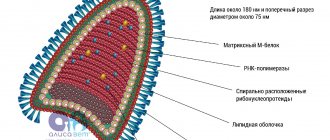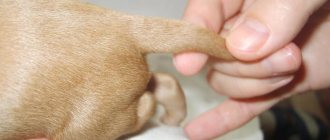Toy Terriers are incredibly smart and loyal dogs.
They will fit perfectly into any family, but, like other breeds, they require special care.
They are small, but not toys at all. Each representative of the Toy Terrier breed has its own character and characteristics.
This must be taken into account if you decide to get just such a dog.
When do your ears stand up?
Toys are born with drooping ears because the cartilage that forms this organ is still very weak and tender. With age , the auricle should become stronger and acquire a standing position.
What time should a toy's ears stand up? Toy terriers do not have a specific age at which this should happen - the process of natural formation of strong cartilage in a puppy takes about six months, starting from birth. If your pet is already at this age, and his ears are still not erect, then this is a reason to sound the alarm.
Many dogs already have erect ears at 2-3 months, and in some, the auricle forms after four months of age.
NOTE!
In long-haired toy dogs, a reclining ear position is allowed. This is due to the fact that the hair on this organ weighs down the auricle, due to which it cannot rise completely.
Is it necessary to dock?
The ears of a toy terrier be cropped , which cannot be said about many other breeds.
If the ears develop without any pathologies, then they should be large, in a standing position, and set high. Due to the position of the ear, you can always determine whether the dog is purebred or not.
Dog handlers claim that due to precisely this correct position of the ears, balance with the long dog legs is achieved. Such an animal looks proportional and harmonious.
IMPORTANT!
A short-haired toy terrier with floppy ears is not allowed to participate in exhibitions. This is considered a disqualifying factor.
Surgical correction of the auricle in toy terriers
A completely different formulation of the question is what to do with the ears of a toy terrier, if the reasons that your pet’s ears do not rise are genetically determined pathologies and injuries.
The gluing method will not work here. The only solution is surgery. And then, in the case of genetic conditioning, even surgery may not help the auricle become properly.
When should you “bet”?
The breed standard clearly states that the ear should be in a standing position and not in any other position. Therefore, if participation in exhibitions is a fundamental factor for you, and ear cartilage is not formed naturally, then it’s time to apply measures from the outside world.
Moreover, a recumbent ear can cause some health problems , primarily with the hearing organ.
But if you do not plan to take Toy to exhibitions at all and agree to carefully monitor the condition of the ears, then you can do without the procedure for supplying the ears.
If a dog appears in the house in order to take prizes, then you need to monitor the condition of its ears:
- watch your puppy from the moment you get him;
- if the puppy is already 6 months old and the ears are lying down, then carry out the procedure for supplying the ears;
- if you see that this process went wrong, then you need to make an adjustment.
Possible causes of problems
The reason why a young toy's ears do not stand up is excessively soft cartilage tissue. But there may be several factors influencing this:
- The slow development of cartilage tissue may be due to heredity. The puppy’s mother may not have received proper nutrition during pregnancy, or there may have been certain pathologies in the dog itself, all of which affected the formation of cartilage tissue in the fetus.
- Incorrect selection of breed representatives for mating also negatively affects the appearance of the offspring.
- The human factor cannot be ruled out. A responsible dog breeder himself monitors the health of the offspring and must correct the ears in a timely manner if the need arises.
- If the Toy puppy is completely purebred, but there are difficulties with the positioning of the ears, then we may be talking about problems with the immune system caused by the stressful state of the baby.
- Deficiencies of vitamins, minerals and calcium can also cause weak ears.
As you can see, the process of setting the ears of toy terriers must be carefully controlled. After all, this is an indicator not only of the pet’s appearance, but also of its health.
Source
Why don't my ears stand up?
For some owners of this breed, it is the ear problem that becomes urgent.
They don't rise for many reasons, but here are the main ones:
- The puppy’s parents had problems with the formation of ear cartilage;
- the baby did not receive sufficient nutrition from the mother in infancy;
- the breeder did not provide the grown puppy with food rich in all the necessary vitamins, i.e. he eats an unbalanced diet;
- the puppy was obtained by mating a long-haired and a short-haired toy terrier;
- calcium deficiency;
- various injuries of the auricle at birth or later;
- stressful situations
NOTE!
If you are afraid that your dog’s ear will not stand up, although you are confident in his health and in the health of his parents, then after consulting with a veterinarian, start giving him vitamin supplements.
Which dogs need ears and why?
Before moving on to ways to correct lop ears, you need to understand why this is necessary. Artificial staging is resorted to for two purposes:
- Aesthetic. Standing ears are fixed in the exterior of many breeds, so their absence can cause disqualification or a low rating at the exhibition.
- Medical. The vertical position of the ears reduces the likelihood of developing hearing diseases. Thanks to good ventilation, pathogenic microflora develop inside much less often.
The hanging form makes the pet look cute and harmless, which negatively affects the appearance of fighting dogs. For this reason, some of them have to do docking for a more impressive image.
Breeds with erect ears
All puppies are born with fold ears, but some of them change their appearance dramatically as they grow up. These breeds include the following:
- German and Belgian shepherds;
- Spitz;
- huskies and huskies;
- Australian Bouviers;
- Yorkies;
- Russian toi;
- Scotch Terriers.
These animals require the help of their owners only in emergency situations when self-staging is behind schedule.
Breeds with cropped ears
Despite active condemnation by animal rights activists, docking is prescribed in the standard for many service breeds. These include:
- American Staffordshire Terriers;
- Caucasian Shepherd Dogs;
- pit bulls;
- Dobermans;
- miniature pinschers;
- Alabaev;
- Cane Corso;
- boxers;
- Great Dane
The ears of these animals do not stand up on their own, so they are given a pointed triangular shape through surgery. It is carried out no later than 4-6 months due to the gradual worsening of pain and the high likelihood of scarring. The easiest time for puppies to undergo docking is in the first 2 weeks after birth.
What to do if your ears don't stand up?
When a toy terrier puppy's ears do not stand up when he reaches six months of age, this is a serious problem for those who got a dog not only to acquire a cheerful friend, but also for exhibitions. Therefore, this issue needs to be resolved as early as possible, before it is too late.
Sometimes, no matter how hard the animal owner tries, the ears still do not take a standing position, and some incorrectly placed ears can no longer be corrected. This means that the pet’s competitive and exhibition career can be put to rest.
Algorithm of action if you notice that your ears do not stand up:
- First of all, you need to contact a specialist. He will ask you some leading questions. This will make it possible to find out the reason why the puppy has problems in terms of positioning the auricle. We must remember that the sooner you find out the correct cause, the sooner you begin treatment, which means you are more likely to be able to eliminate the pathology;
- The dog will need to undergo a course of treatment prescribed by a doctor. These can be special tonic preparations, as well as vitamin supplements;
- Review your pet's diet and consider: does he receive a sufficient amount of all the elements necessary for growth and development? Be prepared for the fact that some products will have to be removed, some replaced, and something new added;
- Make sure your animal gets calcium. It is sold separately at the vet. pharmacies, but you can prepare, for example, calcined cottage cheese for your pet;
- Together with the above, gluing the ears of a toy terrier has a productive effect. Thus, the ear cartilages will always be in a standing position and strengthened due to all the supplements and vitamins that the dog receives after the start of treatment;
- If, after the gluing procedure is carried out, you see that the ears are not fully erect, then it is worth carrying out this process with individual parts of the auricle, and not with the entire cartilage;
You must keep in mind that even if you follow all the recommendations and carry out all the necessary procedures, your toy terrier’s ears may still not rise. If this happens, all you have to do is accept it. The dog will not lose the best qualities of its character from this factor.
Expert opinion
Kozhevin Semyon Kirillovich
Expert dog handler.
Nowadays this problem is very common, especially when you consider that many new owners take Russian Toy puppies without fully understanding all the features of their maintenance. The main thing is to avoid deviations in ear development at all, but if you already have some suspicions, then don’t hesitate. You can consult with the breeder from whom you took the puppy, or go to the veterinarian - they will give you recommendations. It is not always possible to raise the ears, but the sooner you start treating this and if you care for the puppy correctly from the very beginning, then no problems will arise.
The main causes of problem ears
At what age a toy terrier's ears stand up depends on the readiness of the cartilage. For the formation of ear cartilage, a balance of calcium and other trace elements in the puppy’s body is necessary. In order for the cartilage to be ready to support the ear, it is important to properly feed both the mother during pregnancy and lactation, and the baby itself.
By two months, the puppy’s diet should contain appropriate supplements in the form of ready-made complexes of vitamins and minerals. Or if the puppy’s food is natural, you need to give him calcined cottage cheese. You can prepare it yourself or purchase it.
Calcined cottage cheese
When a Toy Terrier's ears stand up, they may fall down again. This happens when there is a lack of calcium in the body during teeth changing. As soon as there is enough calcium in the diet, the problem will solve itself. But there will still be a strip at the fold. This dog is no longer suitable for exhibition.
Why ears may droop
Several reasons why a toy terrier's ear has fallen off:
- stress;
- change of environment and place of residence;
- sudden change in diet;
- illness and weak immunity.
Another reason why the toy terrier does not have erect ears is the crossing of smooth-haired and long-haired toy terriers. This situation is ambiguous. Sometimes the ears will stand up, for example, if the mother had little hair on her ears and the cartilage was well formed.
The most gentle method
The most acceptable and traditional way of setting up the ears is considered to be gluing.
For this procedure to be successful, you must strictly follow all the rules of this procedure and not deviate from them. If you make a mistake, it can only harm your pet's ears, and you will have to spend money on surgical correction.
Rules for how to raise a puppy's ears by gluing:
- You will need to stock up on adhesive tape 2 cm wide, scissors and a splint - its role can be played by a cotton swab or a long strip cut from some kind of plastic;
- Cut two pieces from the adhesive plaster. Their dimensions should be half a centimeter less than the tip of the ear and one centimeter below the fold line;
- Place adhesive tape on the inside of your ear or both ears. It is important to arrange the pieces correctly;
- Cut two more pieces from the adhesive plaster, but smaller than the previous ones;
- Take the tire, which must be shorter than the second parts cut from the adhesive plaster, and glue it on them;
- Stick the second pieces with the splint onto the patch that is already glued to your toy terrier's ear;
- The gluing does not last for several days; weeks may pass before this structure can be removed. The main thing is to carry out the procedure regularly as the patch peels off. Replace it and the tire with new ones from time to time;
- After a few days, start massaging your pet's ears. This should be done every day for 5-10 minutes.
IMPORTANT!
Be sure to pet the puppy during the entire gluing procedure. This will calm him down.
so let's get started
1. Cut off a piece of the patch, approximately 4 centimeters. We recommend carefully cutting out the ends of the patch, rounding them on all sides.
2. Apply the patch from the inside along the entire ear so that the lower edge of the patch is glued below the fold line of the ear by 0.5-1 centimeter. We press the patch very carefully to the ear, making massaging, rubbing movements when gluing.
3. We make a tire. To do this, take a plastic card and cut out a strip of about 0.5 cm in width and 3 - 3.5 cm in height. The height of the splint should be less than the length of the strip of plaster that we glued to the inside of the ear. The ends of the plastic strip, which will serve as a splint for us, must be rounded so that they do not rub or injure the delicate skin of the inner surface of the puppy’s ear.
4. Then we cut out another piece of the patch, slightly smaller in size than the one we pasted as the first layer from the inside of the ear. We cut off the ends of the patch, rounding them on all sides.
5. Take the prepared splint (plastic strip) and place it on the middle of the piece of plaster we prepared with its adhesive side.
Before gluing a prepared piece of plaster with a splint attached to it onto a piece of plaster previously glued to the ear, it is necessary to take into account that the height of the splint (plastic strip) is placed in such a way that it is 0.5 centimeters below the fold line of the ear, but In no case should it fall below the previously glued patch, otherwise the splint will rub the ear. The width of the stick is located almost in the middle of the ear.
6. Now we take a piece of the patch with a splint strip attached to it and glue it over the previously glued piece of the patch, taking into account the above recommendations along the entire length of the ear. Just as before, we press the patch very carefully to the ear, making massaging, rubbing movements when gluing.
The standard stipulates that the ears should be large, erect and high-set. If the ears are not set high enough, they will certainly end up floppy and not very stable. When the longhaired variety of Toy Terriers becomes heavy with hair, their ears easily become semi-erect or droopy. Therefore, the most desirable position of the ears is one in which the inner edges of the ears are as close to parallel to each other as possible. At the next stage of gluing the ears, we will strive to obtain exactly the desired position of them, while ensuring that the inner edges of the ears are parallel to each other.
7. Prepare stationery tape. It is the tape that is very convenient for gluing the ears of long-haired toy terriers, since it does not spoil the decorative fringes on the ears and is easily removed without damaging the hair. For smooth-haired Toys, the tape can be replaced with a medical adhesive plaster.
8. Take the ear by the tip and pull it up and slightly to the side, towards the puppy's head. Then turn the ear counterclockwise (counterclockwise when gluing the dog’s right ear, clockwise when gluing the left ear), twisting it into a “tube”, while continuing to keep the ear raised and taut.
9. Now, with a strip of tape, slightly moving away from the base, wrap the ear around 2-3 times.
Repeat the same procedure with the other ear, making sure that the tips of the ears are at the same level.
Don't wrap the tape too tightly. If you did everything correctly, the ears will turn into vertical white horns with a small ear tip at the top. The tip should not hang down, but stick out confidently from under the patch upwards.
If after gluing the “ears-horns” look crooked, it means you made a mistake and need to immediately start over.
If, after some time, the tips begin to fall off, then wrap the ear with tape in the middle, and, if necessary, in the upper part. After 10-15 days, the “horns” can begin to be “lightened.” That is, do not wrap the ear in several places, but only at the base.
The tape, after gluing the ears of long-haired toy terriers, does not last very long - 3-5 days, after which it peels off and falls off the ears on its own. Therefore, as soon as the tape loses its adhesive base and falls off the ears, the ears must be screwed back into tubes with tape.
If the puppy’s ear cartilage is very weak, and after gluing the ears still do not stand in the form of “horns”, but fall, then it is recommended to connect both ears with tape, thus making a “bridge” between the ears. To do this, wrap the ear tape around the base once, and then make a “bridge” to the other ear. Now wrap the strip around the base of the other ear and return to the first, bringing the sticky sides of the tape together.
The “tubes” themselves are unstuck after 3-5 days, giving the ears a rest for a short time (no more than 1 day), without peeling off the patch with a splint (plastic strip) applied along the entire base of the ear. After a short short rest, we make the “horns” again, wrapping the base of the ears with stationery tape as indicated in steps 7-9.
It happens that ears that are almost erect suddenly fall again during the period of changing teeth or active puberty. Don’t be alarmed, but immediately, without hesitation, start gluing them. Sometimes ears have to be glued up to 1 year.
Factors influencing the development of cartilage tissue
Animal age
Age is an important factor that affects the development of the ears. Nature intended that during the growth and development of a puppy, nutrients, vitamins and microelements go towards the construction and final formation of vital organs and structures.
And soft cartilage tissue (rich in elastic fibers) is nature's way of reducing injuries early in life, while puppies are clumsy. For these reasons, the ears of toy terriers begin to rise only by two to three months of life. The process of formation of the auricles is finally completed by the time of full maturation and formation of the body; it is generally accepted that this moment occurs by the age of one year.
Stress factor
Stress is also an important factor that can affect the development of the ears, but also the immune system. Let's take a closer look. You've probably heard the phrase that all illnesses are caused by stress. Yes, she's fair.
During stressful conditions, the adrenal cortex secretes a group of hormones (corticosteroids), they increase the body's endurance. When releasing corticosteroids, most of the processes occur at the expense of reserves, depleting the body and reserves, including vitamins and minerals. As a result, the dog is weakened, immunity is reduced, and the psyche is shaken. What could be stressful for your beloved toy terrier? Anything: active training, moving, repairs, exhibitions, visits to the veterinarian, mating dates, whelping, the arrival of a baby in the family. Be sure to watch your pet and note the moments that bother your pet. And try to reduce such situations to a minimum. If you cannot avoid them, you can resort to using sedatives for animals. There are many such drugs on the market, here are a few:
- "Fitex"
- "Fospasim"
- "Stop stress"
- Da-ba Relax Plus,
- "Adaptil"
- Help Dog,
- Virbac Anxitane.
The drugs are produced in various forms: drops, tablets, sprays. You can independently choose the appropriate type of drug for your pet based on price, quality and method of use. However, advice from a veterinarian will not hurt.
How to clean your ears?
You cannot clean your toy terrier's ears every day. This will damage the delicate tissue of the ear. This must be done as soon as it gets dirty, but if in doubt, consult a specialist.
To clean the ears, you need cotton pads or swabs, boiled vegetable or olive oil, or a special product for this procedure.
To avoid damaging your ear while cleaning, you need to hold him in your arms so that he feels comfortable. Clean the inside of your ear with a swab moistened with warm water, but do not rub too much.
After this, put a few drops of oil or a special product into your ears - this will soften dirt and earwax. Wait a little and then insert a swab into your ear to collect any remaining dirt. Finally, you need to wipe your ears with a soft cloth.
How to properly glue to install them?
The process of correctly positioning the ears is called gluing. It's not complicated at all. The main thing is to prepare everything you need in advance. To perform gluing manipulations, the following set of items is required:
- hypoallergenic patch;
- scissors;
- antiseptic;
- small pieces of plastic or cotton swabs.
Next we carry out the following manipulations:
- We cut out two blanks from the plaster, similar in shape to the inside of the dog’s ears.
- We disinfect the ears themselves and let them dry.
- We start pasting from the inner corner and move further around the circumference as quickly and safely as possible. We try not to rub the surface with the patch so as not to cause irritation.
- We attach cotton swabs with adhesive tape vertically to each ear on the first layer of sizing.
- You cannot tighten the frame tightly; the puppy must feel completely comfortable so that there is no desire to itch.
Under no circumstances should the ear canal be sealed. Toy's ears need to breathe.
It is permissible to keep the reinforcing frame for no more than two weeks. During the formation of the shell, you should try to stroke the dog in the area of the ears as little as possible, so as not to attract his undue attention to this area.
In addition to the gluing itself, it would be a good idea to review your pet’s diet. It should contain foods containing calcium in excess. It is also a good idea to introduce dishes containing gelatin, which helps improve the condition of cartilage tissue.











